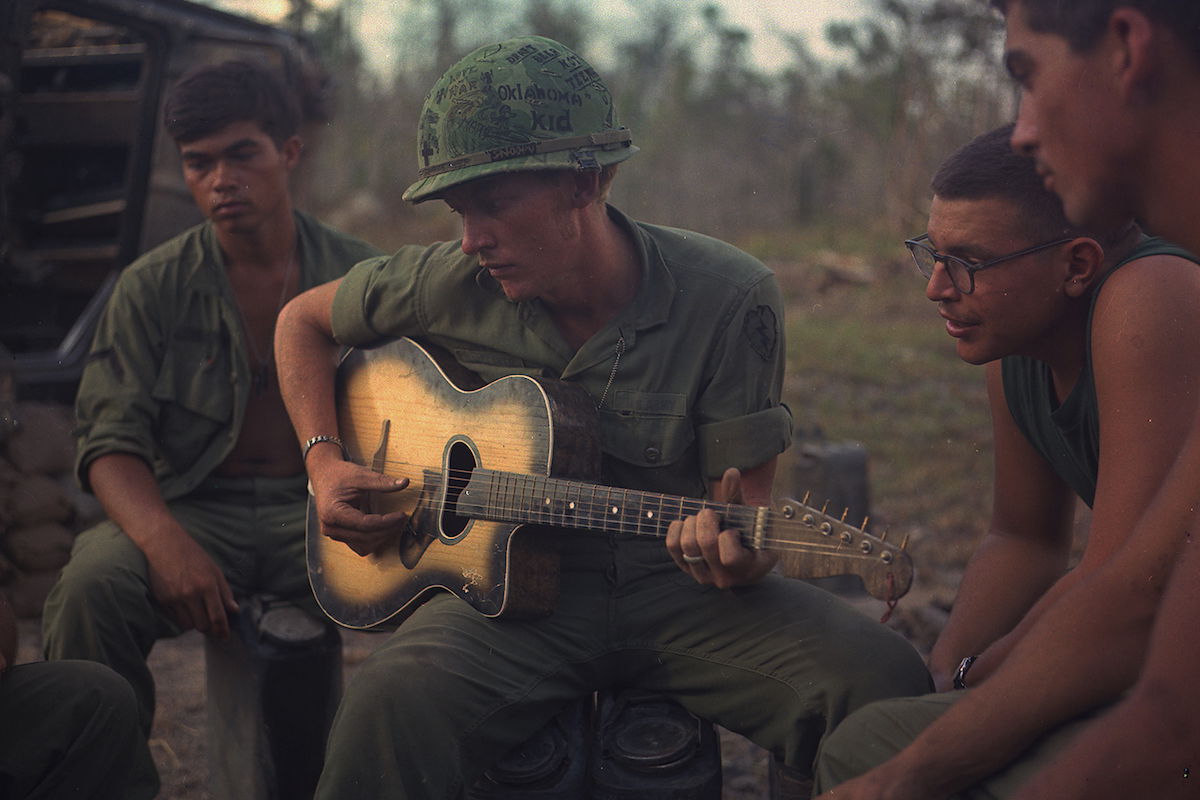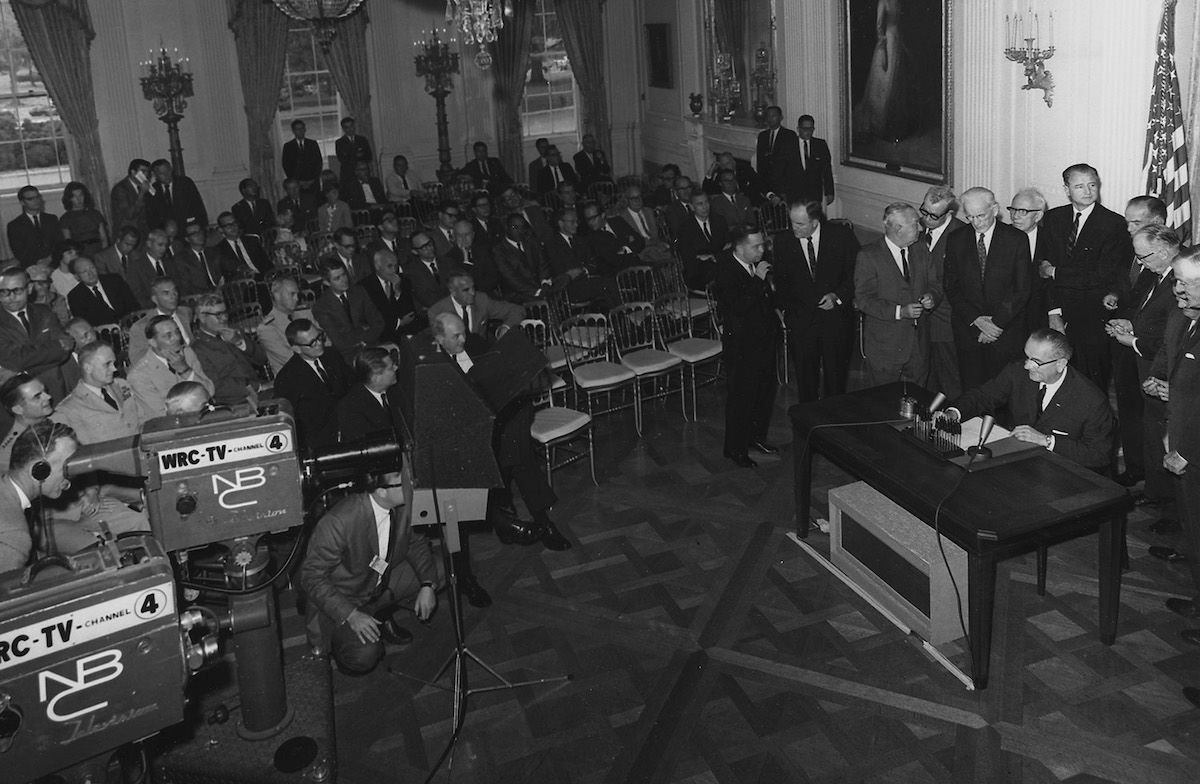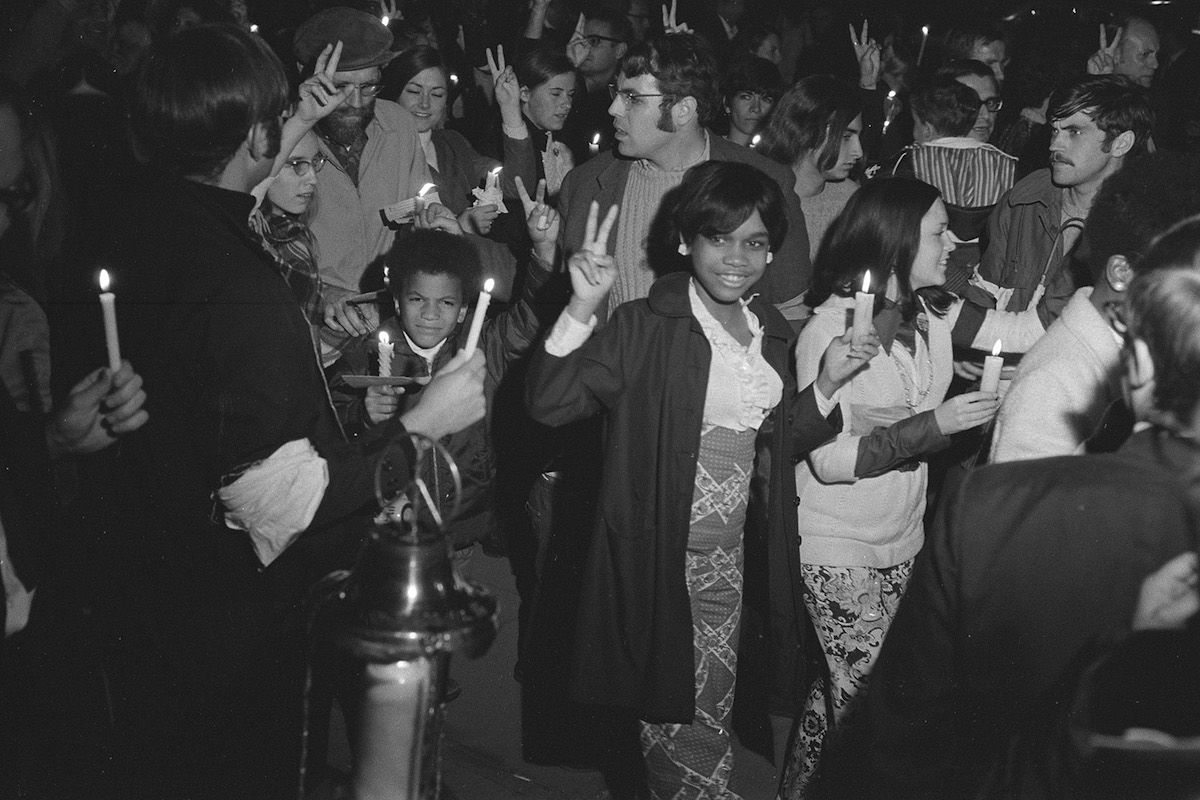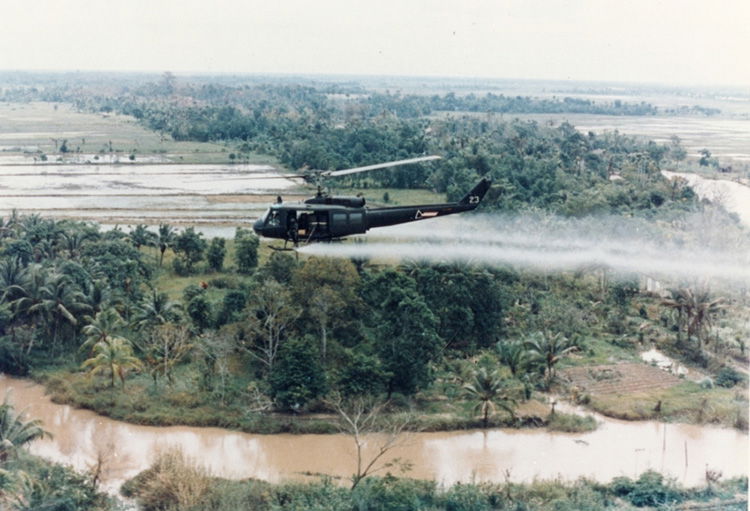The Vietnam War: A History in Song
The ‘First Television War’ was also documented in over 5,000 songs. From protest to patriotism, popular music reveals the complexity of America’s experience in the Vietnam War.

US soldiers gather around a guitar player during Operation Yellowstone, 18 January 1968. NARA. Public Domain.
In the early 1970s, an obscure Louisiana-based country singer called Bob Necaise released ‘Mr. Where is Viet-Nam’. In the song, Lil Gary Dee, a ‘little boy not yet four years old’, asks:
Mister where is Vietnam?
Is it very far away?
I want to see my daddy
Will you take me there today?
By December 1961, under President John F. Kennedy, the US had 3,205 military personnel stationed in Vietnam. By the end of the 1960s, this enigmatic country would become the most controversial issue facing the US, dividing society, debated in Congress, demonstrated for and against on the streets – and documented in song.
Vietnam has been called ‘the First Television War’. But, as Billboard magazine reported on 4 June 1966, ‘few conflicts have evoked such a spate of musical production’. As the magazine revealed, well over 100 Vietnam records had been released since that January alone. Fifty years on, more than 5,000 songs have been recorded about the war, forming an international conversation about a conflict that tore apart the fabric of politics, society and culture. With the US divided between ‘hawks’ and ‘doves’, music became a powerful communication tool for both sides.
‘How many kids did you kill today?’
In the war’s early stages, protest songs voiced the concerns of a minority movement. Most Vietnam songs released during Kennedy’s presidency articulated a reluctance to be drafted. In 1962, the Californian folk duo Goldcoast Singers released ‘Please Mr. Kennedy’, with an unambiguous message to the president: ‘I don’t want to go’. Fewer than 80 American deaths were recorded between 1956 and 1962, compared to over 16,000 in 1968 alone.
One of the earliest notable protest songs of the JFK-era was published in the New York folk magazine Broadside on 20 September 1963, two months before Kennedy’s assassination. ‘Talkin Vietnam’ by Phil Ochs criticised the government for ‘training a million Vietnamese, to fight for the wrong government, and the American way’. It also attacked South Vietnam’s Catholic president Ngo Dinh Diem for his one family rule and suppression of the majority Buddhist population: ‘families that slay together, stay together’. However, songs that focussed solely on opposing the Vietnam conflict were uncommon until 1964.
The turning point was the Gulf of Tonkin Resolution. On 10 August, Congress passed the resolution authorising President Lyndon B. Johnson to send hundreds of thousands of troops to maintain a non-communist South Vietnam. As US troop levels increased from 59,900 to 448,800 between 1965 and 1967, songwriters directed their anger at the president.
Distrust of LBJ was expressed by folk singer Tom Paxton in ‘Lyndon Johnson Told the Nation’ (1965). Paxton satirised the president’s actions: ‘though it isn’t really war, we’re sending 50,000 more’. In ‘Hey, Hey LBJ’ (1967), Bill Fredericks, backed by a group of children, asked ‘how many kids did you kill today?’. Jacqueline Sharpe, a prominent folksinger and social activist, mocked the administration’s stubborn insistence on sticking to its objective in her song ‘Honor Our Commitment’ (1966), ‘even if the world goes up in the smoke of a mushroom cloud’.

On 30 April 1967, Martin Luther King Jr delivered a speech, titled ‘Why I Oppose the War in Vietnam’ at the Riverside Church in New York. It was later released by a Motown Records subsidiary. King pressed home the relationship between Vietnam and the Civil Rights Movement, pointing to the ‘cruel irony of watching Negro and white boys on TV screens as they kill and die together for a nation that has been unable to seat them together in the same school room’, as well as the killing of ‘little brown Vietnamese children’. King was not the first person to express this view. Nina Simone released ‘Backlash Blues’ in March 1967:
You send my son to Vietnam
You give me second-class houses and second-class schools
Do you think that all the coloured folks are just second-class fools?
For decades, Civil Rights groups had struggled with accusations of being unpatriotic and communist, leaving many black artists to tread cautiously. King’s public move against the war opened the flood gates. Dozens of songs by black musicians drew comparisons between Civil Rights and Vietnam, including activist Matt Jones who refused to fight in ‘Hell No! I Ain’t Gonna Go’ (1970), telling his audience that ‘the Vietcong just like I am’.
In 1968, North Vietnamese and Viet Cong forces launched coordinated attacks against the South, infiltrating the US Embassy in Saigon. Following the Tet Offensive, public support for withdrawal from Vietnam increased from 19 to 55 per cent. The horrors of the war were becoming unignorable. The US dropped 388,000 tons of Napalm B on Indochina between 1963 and 1973. A jellied gasoline mixture, it stuck to skin, causing severe burns when on fire. A group of active-duty GIs from Idaho, called the Covered Wagon Musicians, offered an unflinching picture of the war in ‘Napalm Sticks to Kids’ (1972):
We shoot the sick, the young and lame
We do our best to kill and maim
Because the kills all count the same
Napalm sticks to kids
With public support for the war waning, withdrawal became a big issue in the November 1968 presidential election. Most candidates supported some form of withdrawal as songs began to emphasise the war’s length, military failures and growing fatality rate. Bob Seger attacked the political system in ‘2 + 2 = ?’ (1968): ‘it’s the rules not the soldier that I find the real enemy.’

Richard Nixon won the election and soon became the focus of protest. Three key events raised pressure on Nixon. Each of them inspired records. The first was the ‘Moratorium to End the War in Vietnam’, a mass demonstration which took place across the US on 15 October 1969, followed by a march on Washington on 15 November. Native-American folk artist Buffy Saint Marie released ‘Moratorium’ in 1971, in which she highlighted the increasingly diverse demographics of the protest movement in the early 70s:
Yes, soldier it’s for you
We’re riskin’ all we have
We’re nailed and jailed the same as you
Our lives are up for grabs
The second was the Kent State demonstration on 4 May 1970, which protested Nixon’s Cambodia incursion, an attempt to cut off North Vietnam’s supply routes to the South via its neighbour. Four students were killed by the Ohio State National Guard. That the war’s brutality had reached American soil shocked the nation. Within weeks Crosby, Still, Nash & Young released ‘Ohio’, placing blame firmly with the government. It was just one of more than 50 songs released about Kent State.
Third, in 1971 the Pentagon Papers, a top-secret study on the history of the war, commissioned in 1967, was leaked to the New York Times by military analyst Daniel Ellsberg. The papers revealed that the public had been misled about the war’s progress. The resulting news coverage inspired Texas band Bloodrock’s ‘Thank You Daniel Ellsberg’ (1972):
I wanna thank you Danny boy
For what you said and done
You’ve stricken from all the pages
But you don’t know that you’re the one
After the Tet Offensive and the subsequent turn in public opinion, commercially minded record labels became less afraid of releasing strong anti-war songs, for example Edwin Starr’s ‘War’ (1970) on Motown. By the 1970s, anti-war songs came from a range of backgrounds and perspectives and permeated popular culture. Anti-war sentiment even spread into the traditionally conservative country genre. John Wesley Ryles’ single ‘Kay’ (1968) featured ‘two young soldiers’ who tell the singer how they ‘hate that war in Vietnam’, while the wounded veteran in George Kent’s ‘Mama Bake a Pie’ (1970) pointedly says:
Yes sir it was worth it for the old red, white and blue
And since I won’t be walking, I suppose I’ll save some money buying shoes
But for every protest song decrying the war’s pointless brutality, there was another side to the story.
The Silent Majority?
Anti-war sentiment fuelled a large discography, but so did anti-communist sentiment. Opinion polls showed vast support for presidential policy across the Heartland and Southern states, in areas with ties to agriculture and religion. Patriotic songs supporting the government and troops filled the country charts and radio stations from the JFK to the Nixon eras of the war.
Jimmy Jack’s ‘Battle of Vietnam’ (1964) described the need to stop ‘the Commie charge’ in Vietnam and ‘keep it free’. In 1965 The Lonesome Valley Singers released ‘It’s All Worth Fighting For’, which articulated Dwight Eisenhower’s Domino Theory. The country group sang:
I guess there are people who think we should go ahead and give Vietnam to the enemy
But then what country would they demand next?
We’ve got to call a halt to this transgression somewhere
And it may as well be here in these jungles of South Vietnam
The US flag was an important symbol in patriotic songs. In Hank Snow’s 1966 ‘A Letter From Viet Nam’, the narrator vowed he would do his best for ‘old glory, the red, white and blue’. And, like the flag, previous conflicts were often alluded to as patriotic symbols. In ‘What’s Come Over This World’ (1965), Billy Carr sang how
My brother fought in Korea,
My daddy in World War Two,
Now there’s a war in Vietnam,
And there’s a job we must do
On 16 March 1968, 300-500 civilians were murdered by US troops led by platoon leader Second Lieutenant William Calley in the south Vietnamese villages of My Lai and Song My. The My Lai Massacre became one the war’s most controversial events and inspired over 90 songs. But most of them supported Calley.
One of the most interesting of these was ‘Thank God, Calley Wasn’t Black’ (1973) by James Armstrong. The song defended Calley’s actions, but pondered what his fate may have been if he was an African-American. Would the public have been so lenient?
The most well-known song defending Calley was the ‘Battle Hymn of Lt. Calley’ (1971), by Terry Nelson, which sold over one million copies. But the massacre also became a symbol of an unjust war. The sleeve of Yoko Ono’s ‘Now or Never’ (1972) featured a horrific photograph of bodies in a ditch taken by army photographer Ronald L. Haeberle. It was one of the most graphic images to appear on a Vietnam War record.
A significant number of pro-war songs were directed at the war’s protestors and the perceived laziness, permissiveness and pacifism of the ‘Flower Power’ hippie generation. Jan Berry, member of the surf rock duo Jan & Dean, mocked the ‘Universal Coward’ (1965):
He just can’t get it through his thick skull
Why the mighty USA
Has got to be the watchdog of the world
Else that greedy USSR
Will bury us from afar
And he’ll never see the missiles being hurled
The narrator of Jack Sanders’ ‘The Vietnam Blues’ (1965), composed by Kris Kristofferson, comes across a ‘strange looking bunch’ of protestors gathering signatures to send a ‘telegram of sympathy to Ho Chi Minh’. The veteran feels ‘down right sick’. As the anti-war movement grew in the late 60s, a large number of records were recorded in support of Nixon. On 3 November 1969, the president had given a speech: ‘to you, the great silent majority: I ask for your support’. Written in response, George Jay’s ‘The Real Silent Majority’ (1969) expressed a desire to ‘unite with you in your search for an honourable peace’.
‘Now I’m 1-A’
According to the Veteran's Administration, of the 3.5 million people who went to Vietnam, 2.2 million did so via the draft. The experience is reflected in hundreds of songs. ‘1-A’ was the classification for those eligible for service, a recognised phrase sung by Richie Kaye in ‘Here Comes Uncle Sam’ (1965): ‘I'm through with school, now I'm 1-A, I got a letter, they are taking me away’.
The line between ‘hawks’ and ‘doves’ was clearly demarcated in songs relating to the draft. While Steppenwolf praised the ‘courage’ of the ‘Draft Resister’ (1969), Smiley Smith released the single ‘I Wish I Had a Draft Card’. Merle Haggard noted that ‘we don't burn our draft cards down on Main Street’ in ‘Okie From Muskogee’ (1969). Originally composed in jest, it became one of the most popular patriotic songs. In one of the standout novelty tracks, Chicago group Seeds of Euphoria advised LBJ in 1967: ‘Let’s Send Batman to Viet Nam’.
Draft inequality was a major theme. Gary Laster emphasised in ‘A Drafted Minor’ (1969) the absurd legal discrepancies affecting those drafted: draft age: 18; voting and drinking age: 21. Creedence Clearwater Revival confronted the inequality between the rich and poor in ‘Fortunate Son’ (1969), inspired by President Eisenhower’s grandson, David, who avoided the draft by joining the reserves.
Many songs also focused on the impact of war on those left behind. Some of these were sentimental: from the early 60s, many ‘soldier boy’ themed songs appeared, including ‘Your Heart Belongs to Me’ by The Supremes in 1962. Each holiday season galvanised sentiment on the home front and over 70 Christmas songs were written about the war. But not every song about absent soldiers was sentimental. Many artists were not shy about confronting the unethical activities of serving soldiers on furlough. The Soul Patrol’s ‘Saigon Strut’ (1968) described GIs visiting prostitutes on the famous Tu Do Street in Saigon, while ‘What’s Been Going On in Viet Nam’ (1968) by Ginger & Jean is told from the point of view of a veteran’s wife who discovers her husband has fathered a child abroad.
War is Over?
The North Vietnamese Army captured Saigon in April 1975. US military involvement in Vietnam was over, but the war continued to reverberate throughout American society. Almost half of the Vietnam War song discography was released in the postwar period.
The first wave of songs appeared between the 1973 peace agreement and the fall of Saigon. Many American songs of this period focused on returning prisoners of war. As part of the Paris Peace Accords, 591 POWs returned to the US in ‘Operation Homecoming’, an event celebrated in Funkadelic’s ‘March to the Witch’s Castle’:
February 12th, 1973
The prayers of thousands were answered
The war was over, and the first of the prisoners returned
Needless to say, it was the happiest day in up to thirteen years for most
For others, the real nightmare had just begun
That nightmare referred to the experience of returning veterans trying to readjust; that the war’s end had terrible consequences for those in South Vietnam who had fought with the Americans was largely overlooked. Only a few records addressed the Vietnamese refugee crisis: ‘The Boat People (A Song of Hope)’ by Canadian jazz singer Dick Maloney, for example.
The 1980s saw a revival of interest in the war. The Reagan-era saw a wave of nationalism that attempted to overcome ‘Vietnam Syndrome’. Applied to veterans, it referred to feelings of guilt or shame about the war, influenced by the domestic climate they had returned to. Reagan spoke about this on 18 August 1980: ‘For too long, we have lived with the Vietnam Syndrome. We dishonour the memory of 50,000 young Americans who died. They deserve our gratitude, our respect and our continuing concern’.
Two prominent themes dominated the new batch of songs. First, the attempt to overcome Vietnam Syndrome; second, Post-Traumatic Stress Disorder, characterised by shell shock, flashbacks and nostalgia. The Charlie Daniels Band released ‘Still in Saigon’ in 1982. The song is told from the point of view of a Vietnam veteran:
The ground at home was covered in snow
And I was covered in sweat
My younger brother calls me a killer
And my daddy calls me a vet
The completion of the Vietnam Veteran Memorial Wall in Washington DC in 1982 led to over 30 songs of remembrance as Americans sought to come to terms with the war. Hawks and doves remained, but the names of more than 58,000 Americans killed became heroes, as sung by Michael J. Martin & Tim Holiday on ‘Who Are the Names on the Wall?’.

But the 1980s was also the decade in which the long-term negative health effects of Agent Orange, a herbicide used in Vietnam to deprive the North Vietnamese guerrillas of concealment and food, became apparent. Peggy Seeger released ‘Agent Orange’ in 1982:
We’d fly above the trail all day and clouds of poison spray
I never thought that chemical would take my life today
But I just found out this morning, the doctor told me so
It killed me in Vietnam and I didn’t even know
Fuelled by anger, a politically conscious anti-Reagan punk movement grew internationally. Over 100 songs used Vietnam as a case study to criticise US interventions in Grenada, Nicaragua and El Salvador. Vietnam continued to be compared to other conflicts throughout the 1990s and 2000s.
The Vietnam War inspired songs on a scale never seen before, or since, and not just in the US. Performed by men and woman of different ethnicities and nationalities, the astonishing breadth of opinions from all levels of society reveals the changing nature of responses to the war. Aided by the development of the portable tape recorder, General Edward Lansdale captured hundreds of songs in Vietnam on tape, performed by US soldiers, Vietnamese guerrillas and civilians. Returning home he identified popular music’s central place in the experience of the war: ‘all along we have been historians without meaning to be. These tapes tell the story of a human side of war.’
Justin Brummer is founding editor of the Vietnam War Song Project and has a PhD on 20th-century American history.